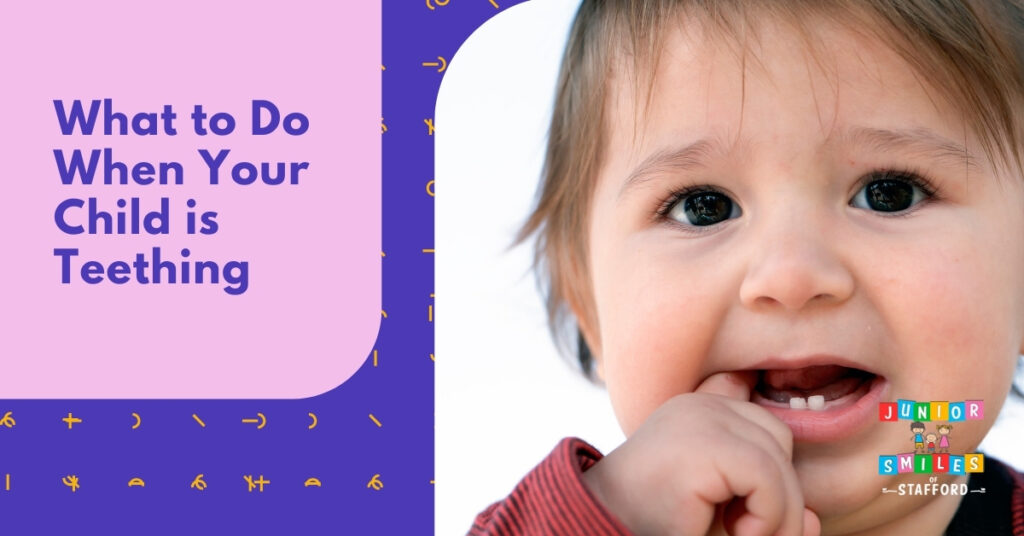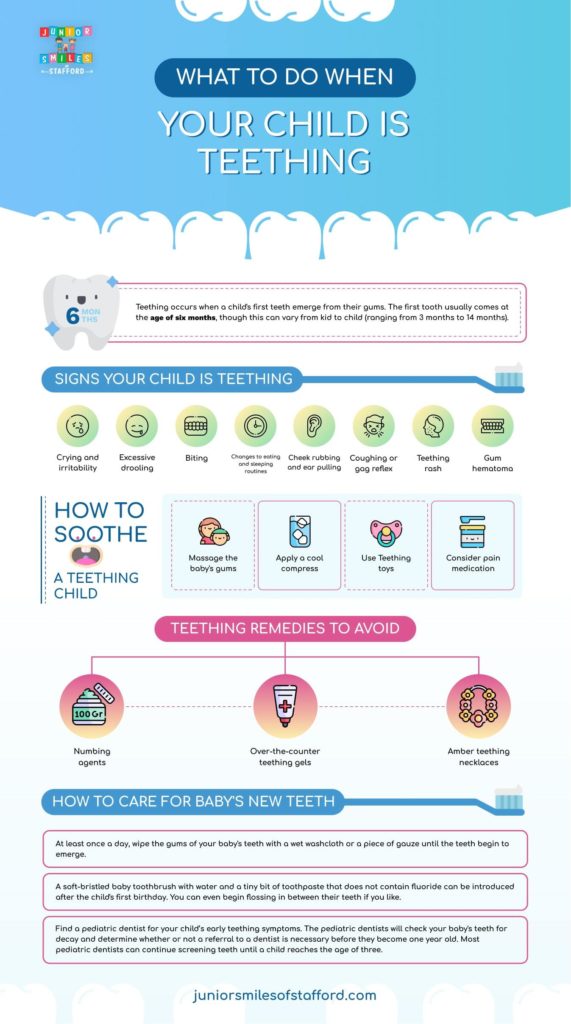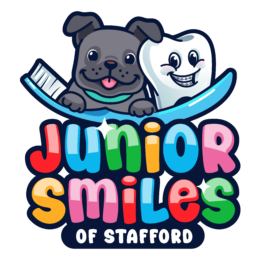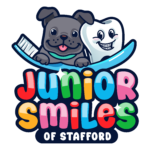What to Do When Your Child is Teething

Teething is the process by which teeth emerge from a baby’s gums for the first time. In this period, both parents and babies can encounter frustration. Making teething a little less painful for everyone can be achieved by knowing what to expect during early signs of teething.

When Does Teething Start?
Teething occurs when a child’s first teeth emerge from their gums. It’s a major milestone for both the infant and the parents. The first tooth usually comes at the age of six months, though this can vary from kid to child (ranging from 3 months to 14 months).
The emergence of teeth varies from child to child, with some children gaining teeth one at a time while others gain teeth in groups. For your convenience, the American Dental Association has created a fantastic tooth eruption chart. It is perfectly normal for your child to have teeth that are coming in early. According to the American Dental Association, your child must see a dentist within six months of the eruption of their first tooth.
First Signs of Teething
Because every child is different, their reactions to the teething phase will be unique as well. Several indications to look out for if you’re wondering, “Is my kid teething?” include the following.
Crying and Irritability
Your baby’s mood may alter significantly when teething, which is one of the most prevalent indicators. Even the most contented infant might become irritated at any time. You may find your child more likely to cry or become easily irritated as a result.
Most of the time, this change in mood will be more noticeable in the weeks leading up to the arrival of their first tooth and will gradually improve with the appearance of other following teeth. When their teeth begin to erupt during their second year of life, you may notice that they grow increasingly irritable once again.
Excessive Drooling
Excessive drooling is another frequent symptom of teething. This can begin as early as ten weeks of age in some babies and last throughout the entire teething phase in others, depending on the individual. While teething, it is typical for babies to drool so much that they soak through their shirt (or their parent’s shirt) in a short amount of time.
No one wants to spend the day in wet clothes, whether it’s a baby or a parent, which is why many parents use bibs to keep clothes dry during the day. The skin surrounding your baby’s neck, chin, and mouth may become inflamed due to excessive drooling.
Biting
An increased interest in biting is one of the first indicators of teething in a child. You could reduce the pressure created by the pain By providing counterpressure to the area when a tooth erupts. When teething, babies will instinctively seek objects to bite down on to receive counterpressure and relieve their discomfort.
You may have noticed that your child is chewing anything and everything they can get their hands on. This can be particularly unpleasant for older newborns who have already grown a pair of teeth if they attempt to bite down their breast milk.
Changes to Eating and Sleeping Routines
Teething is a 24-hour-a-day undertaking, which means it impacts all aspects of a baby’s development. A child may have difficulty nursing or drinking from a bottle during teething since sucking can be unpleasant to the teething gums. They may refuse solid foods that they enjoyed just a few days earlier if they are older.
Teething pain might cause sleep disturbances as well. Even babies who previously slept through the night may find themselves suddenly more awake during the night as a result of teething.
Read More: Teething Rashes: Symptoms and Treatments
Cheek Rubbing and Ear Pulling
During the teething phase, a teething baby may tug on their ears or massage the inside of their cheeks.
The neural pathways that run through the ears, mouth, and cheeks are all the same. Therefore, pain in the jaws caused by teething may be felt in the cheeks and ears.
These feelings are particularly noticeable in babies who are developing their first molars. This particular teething symptom can also be a sign of an ear infection. It’s a good idea to consult with your trusted pediatric dentist if it lasts more than a few days, especially when it’s accompanied by other cold or flu-like symptoms such as congestion and fever.
Coughing or gag reflex
Babies can gag and cough from having their mouths constantly filled with spit. Provided your child is not showing any other cold, flu, or allergies indicators, there is no reason to worry.
Teething rash
The continual leak from your teething baby’s mouth, chin, and even his neck and chest may cause chafing, chapping, redness, and rashes in and around his mouth, chin, and even his neck and chest. Patting it away will assist in keeping it from irritating you.
You can also use Vaseline or Aquaphor to establish a moisture barrier around the affected region and then moisturize with a light, unscented skin cream as needed. Nursing lotions such as Lansinoh are also excellent for safeguarding the delicate skin of babies.
Gum hematoma
Does it seem like your infant has a bluish lump behind their gums? If there is blood or a gum hematoma under the gums due to the eruption of a tooth, it is not a cause for alarm, and it is not harmful.
A cool compress or washcloth applied to the gums can assist in easing the discomfort and may also aid in the healing of the hematoma. If the hematoma continues to grow, you should consult your trusted pediatric dentist.
Teething symptoms might vary significantly from infant to baby, but you can generally expect to see at least some (and possibly several) of them at some point.
Read more: 5 Stages of Teething in Babies and Kids
How to Soothe a Teething Baby?
What soothes a friend’s baby may or may not comfort yours. It is essential to try different things. It is possible that you’ll need to try several other things to make your child feel better:
Massage the baby’s gums
Gently massage your baby’s gums with a clean finger if it appears to be bringing them some relief. Apply hard pressure while remaining soft. Your baby’s gum tissue will receive more blood circulation as a result, which may help to lessen inflammation and pain.
Apply a cool compress
In addition, applying cold temperature to your baby’s gums helps relieve discomfort. Some parents would chill a teething ring in the refrigerator (not the freezer!) before handing it to their child to chew on while they are sleeping.
You can also apply a cold spoon to your baby’s swollen gums if they are particularly sensitive. If your infant hasn’t developed teeth yet, you should use a cold spoon as a safety precaution. They may accidentally chip their fragile teeth when chewing on a metal utensil.
Teething toys
Teething children are naturally drawn to chew, and for a good reason: chewing counter pressures the teeth as they push into their mouths, thus alleviating the pain they might experience.
Things such as bumpy rubber teething toys and your clean finger can be used as counterpressure during the teething process. A soft, wet toothbrush (without toothpaste) can also be used to rub the baby’s gums firmly.
The fact that it hurts first may cause your infant to resist, yet it is frequently the most effective natural cure for teething pain and provides relief quickly.
Consider pain medication
Acetaminophen and ibuprofen, which are available over-the-counter, can also be used to ease the pain. Pain medications are safe to give to babies if they are administered carefully. These drugs can help alleviate the discomfort associated with teething, but they should only be used temporarily.
Remember to consult your doctor before administering medication to children under the age of two, or if you believe you may need to administer pain relievers for more than a day or two after delivering the drug.
What teething remedies should you avoid?
While you may be willing to accept any form of comfort for your baby’s teething pain, there are a few teething cures that are not safe and should be avoided. These include:
Numbing agents
Never put rubbing alcohol, benzocaine, or lidocaine on your baby’s gums since they can be irritating for them. The Food and Drug Administration (FDA) advises against topical numbing medications because they can put children under the age of two at risk for low oxygen levels in their blood.
Over-the-counter teething gels
According to the FDA, parents should avoid using over-the-counter teething therapies, such as herbal or homeopathic teething gels, because they have not been proven to help children with teething problems. Belladonna is a component in some products that can induce trouble breathing and seizures when used.
Amber teething necklaces
Amber teething necklaces are not scientifically proven to be effective. Pediatricians generally advise against using them, mainly because they can choke or strangle children.
Why Teething Symptoms May Be Confused with Cold Symptoms?
Teething is believed to begin at the age of six months, according to research. This occurs in parallel as infants’ immunities, passed down to them from their mothers through the placenta, decline. This indicates that the infant’s immune system is beginning to take hold and develop. Infants are particularly susceptible to mild infections during this period. Because of these two changes, teething symptoms can be mistaken for those of a small illness or cold, and the reverse is true.
This explains why only 70-80 percent of parents reported their infant’s teething symptoms; it is possible that the remaining 20-30 percent of parents connected the symptoms with a mild illness or cold.
How to Care for Baby’s New Teeth?
Even before your baby’s first tooth emerges, good dental hygiene is essential:
At least once a day, wipe the gums of your baby’s teeth with a wet washcloth or a piece of gauze until the teeth begin to emerge.
Once your kid has teeth, you should clean their mouth at least twice a day in the same manner. Immediately following feedings is an excellent time to do this.
A soft-bristled baby toothbrush with water and a tiny bit of toothpaste that does not contain fluoride can be introduced after the child’s first birthday. You can even begin flossing in between their teeth if you like.
The pediatric dentists will check your baby’s teeth for decay and determine whether or not a referral to a dentist is necessary before they become one year old. Most pediatric dentists can continue screening teeth until a child reaches the age of three.
Find a Pediatric Dentist for Your Child’s Early Teething Symptoms in Stafford VA
Dr. Azar and our team at Junior Smiles Of Stafford are experts in pediatric dentistry. We are here to answer any questions you may have regarding early signs of teething in Stafford, VA, and surrounding areas. Contact Junior Smiles Of Stafford today to schedule a free consultation. Call now (540) 699-2441.

